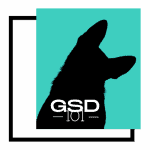The eyes of a German Shepherd are some of the most mesmerizing and expressive of all canines. German Shepherds have a unique look, with almond-shaped eyes that are not only beautiful, but they can also tell us a lot about their health and well-being. Unfortunately, like all breeds, they can also suffer from eye problems. To ensure that your pup’s eyes stay healthy and strong, you must give them proper care.
This guide will provide a comprehensive overview of German Shepherd eyes, from anatomy and function to common problems and how to care for them properly. It will also talk about supplements and food that support eye health.
The Magnificent Eyes of the German Shepherd
Your GSD’s eyes are not only functional but attractive. The eyes of this second most popular dog breed in the world is probably one of the features that drew you in. These beautiful eyes can come in a range of colors.
Normal Colors
German Shepherd’s eyes are blue at birth, but this color changes as they mature. Usually, between birth and the 10 week mark, your puppy’s eyes will begin to change, taking on a variety of hues before settling down to your pup’s natural color.
Most German Shepherd dogs have the following colored eyes:
- Dark brown
- Light brown
- Pale yellow
- Deep amber
- Light hazel
The original shepherd dogs were a mix between wolf and domestic dogs, so their eye colors reflect those genetics.
Specialty Colors
German Shepherds can also have uniquely colored eyes. Eye color is affected by melanin and genetics. The more melanin your dog’s eyes produce, the darker their eye color. The less melanin, the lighter.
Blue eyes are a recessive gene. Both parent dogs have to pass along the gene for your dog to inherit this eye color. This can even occur if both parent dogs have brown eyes. It’s about the genes they carry.
Your German Shepherd’s blue eyes can have a large variation in color. They can come in the following shades:
- light blue
- Dark blue
- Violet
- Deep gray
- Light gray
Heterochromia
Heterochromia is when a German Shepherd’s irises are different colors from birth. This is a random genetic mutation. It does not cause eye issues. There are three types of heterochromia.
Complete heterochromia is when each eye is a different color. Often, one of the eyes will be blue and the other will be brown.
Central heterochromia is when the inner part of the iris is a different color than the outer part. The inner color usually looks like a firework inside the outer color. The outer hue is usually blue or green.
Finally, sectoral heterochromia is incredibly varied. There are two colors in a single iris, and these two colors can have many different patterns.
Eyesight Features
For years, scientists believed dogs were color blind, but recently, the literature has gone away from that. Dogs see colors, but they don’t see them as we do.
This doesn’t mean German Shepherds have bad eyesight, but it isn’t their strongest sense. Your dog’s eyes are placed more towards the sides of his head for better peripheral vision. They can also see in pretty dim lighting. They can track movement really well, too. All of these make your German Shepherd great at his job as a shepherd.
Common Eye Problems in German Shepherds
Although a dog’s sense of smell and hearing are stronger than their eyesight, eye problems can be very disruptive to a German Shepherd’s life. So, it is important to understand the types of eye issues GSDs can get and how to identify them.
Dry Eyes
Tears are important in keeping your German Shepherd’s eyes moist, free from debris, and help fight off infections. However, if your GSD stops producing tears, this can cause dry eye syndrome. The symptoms of this illness are
- Red, painful eyes
- Frequent squinting and blinking
- Mucus-like discharge
- Possible vision disruption
- Dry cornea
Dry eyes can be caused by genetics, immune system disorders, canine distemper, medications, and trauma.
According to PetMD, you can treat dry eyes with over-the-counter medications, “Over-the-counter artificial tears and eye lubricants are critical to the overall comfort and stability of the eyes when your dog has dry eye syndrome, especially early on. It is important to use products approved for dogs, and to discuss any product option with your vet first.”
Most cases of dry eyes can be treated with medications. However, some require surgery.
Cataracts
Cataracts cause your German Shepherd’s eyes to cloud over. This is a disease that occurs when the proteins of your dog’s lens start to bind together. The cloudiness makes it difficult for light to pass through the lens.
This disease is usually genetic, however, eye trauma and other eye diseases can also contribute to cataracts.
If you notice your dog’s eyes beginning to get cloudy, they should see a vet as soon as possible. The earlier you treat the disease, the better the outcome.
Most cataracts are treated with eye drops and surgery. If left untreated, your dog can go blind.
Pannus (Chronic Superficial Keratitis)
According to VCA Animal Hospitals, “Pannus or chronic superficial keratitis is an immune-mediated condition affecting the cornea or clear part of the eye. It occurs primarily in middle-aged German Shepherd dogs and Belgian Tervurens, but other breeds may also be affected.”
Pannus begins with a pink mass on the cornea. This can be located on one or both eyes, but usually one is worse than the other. Your GSDs third eyelid will become inflamed and the pink mass will become a large, painful lesion. This illness will eventually lead to blindness without treatment.
A combination of corticosteroids and antibiotics is usually a lifelong treatment for this illness. You cannot cure pannus; you can only stop it from progressing further.
Glaucoma
When there is abnormally high pressure in the eyeballs, this is called glaucoma. The natural fluids in the eyeballs don’t drain properly, resulting in a build up of liquids that cause the pressure.
Dogs can get glaucoma from genetics or eye trauma. Symptoms of glaucoma include:
- Watery discharge
- Swollen eye
- Slower eye movements
- Lethargy
- Loss of appetite
- Excessive sleeping
- Pawing at the eye
- The eyes look like a blue film is over them
These symptoms can onset suddenly. According to Web MD Pets, “Any sign of glaucoma in dogs is an emergency. If you think your dog may have glaucoma, call your vet for an appointment. They can use an instrument called a tonometer to measure pressure in your dog’s eye and diagnose the problem.”
The two major treatments for this disease are medications to reduce the pressure and/or surgery to drain some of the fluid.
Corneal Dystrophy
The term corneal dystrophy refers to any condition that creates a cloudiness of the cornea. This is a condition caused by genetics. There are three major types: epithelial, stromal, and endothelial.
Epithelial corneal dystrophy is when a white cloudy lesion occurs on your German Shepherd’s cornea. This is usually painful for your dog.
Stromal corneal dystrophy occurs in younger dogs. The white, cloudiness is not painful and more at the center of the cornea.
Endothelial corneal dystrophy affects the deepest layers of the cornea. The disease progresses slowly and almost unnoticeably at first. But, then it leads to painful lesions and vision loss.
Most dogs with corneal dystrophy are fine and don’t have any impaired vision. However, if your dog is suffering from eye lesions, these will need treatment.
Progressive retinal atrophy
According to Dr. Jerry Klein, Chief Veterinary Officer for the American Kennel Club, “Progressive retinal atrophy is, as the name implies, a gradual progressive degeneration of the photoreceptor cells in the retina, causing gradual vision loss, eventually leading to blindness.”
The disease usually occurs in puppyhood, but it progresses slowly. PRA is an inherited disease. Puppies will not develop photoreceptors properly, and they begin to decay as your dog ages.
The most common sign of PRA is hesitancy when your dog moves or walks in the dark. Your dog may also have pupils that are dilated more than usual. Also, a strong reflection of light on your dog’s eyes is another sign.
There is no treatment for this disease at the time.
Microphthalmia
Microphthalmia is when your German Shepherd’s eyes are smaller than normal. This is a genetic mutation, and because the eyeball didn’t grow properly, usually some of the parts of the eye also didn’t form.
Symptoms of this condition include:
- Blindness
- Small eyelid opening
- Cloudy eyes
Although the condition is incurable, there are ways to treat secondary infections and to make your dog comfortable with his impaired vision.
When to see a vet
After reading this list of scary eye conditions, you may be nervous about your pet’s eye condition. In most cases, German Shepherds who come from reputable breeders have been screened for genetic issues. You probably have a healthy, happy dog. So, try not to worry.
However, if you have recently noticed any kind of cloudiness, redness, discharge, or signs of pain or impairment, it is important to contact your vet. Most of the aforementioned diseases can be better treated if caught early.
Daily Care for German Shepherd’s Eyes
In order to keep your German Shepherd’s eyes looking their best and brightest, you will want to keep their eyes properly cared for. You can do this with cleaning, remedies, and eye drops.
Proper cleaning
Keeping your German Shepherd groomed will prevent pathogens and obstructions from entering your dog’s eyes. Chemicals, dirt, and other irritants that may bother your GSDs eyes can be transported on the fur.
If your dog seems to have crust or debris in his eye, take a warm, damp cloth and gently clean away the debris.
Some dogs develop “tear stains,” which is an area near the tear ducts where you can see a trail where tears have fallen. The fur is usually stiff here. This can poke at and irritate your dog’s eyes. Gently clean this area frequently to ensure eye health. You can check out this eye wash on Amazon to clean stubborn tear stains.
If you’d like some more information about cleaning your dog’s eyes properly, watch this video:
Homeopathic remedies
There are also some homeopathic remedies on the market that sell supplements for your dog’s eyes. These use a combination of herbs to soothe and care for your dog’s eyes. You can check out PetAlive Eye-Heal – Natural Herbal Formula Promotes Eye Health.
Eye drops
If your dog suffers from dry eyes, you can also buy over-the-counter eye drops to help soothe the dry, painful, and itching symptoms of this condition. This is also helpful if your German Shepherd has eye allergies. You can check out I-DROP VET PLUS Lubricating Eye Drops for Pets.
To see how to properly apply eye drops to your dog’s eyes, watch this video below:
How do I promote eye health in my German Shepherd?
To bolster your German Shepherd’s eye health, you can also feed your dog some foods that promote eye health. These can give your dog the extra nutrients he needs for his beautiful eyes.
Blueberries
To prevent macular degeneration, serve your German Shepherd blueberries frozen as a quick treat. This nutrient-rich fruit contains the following:
- Resveratrol
- Quercetin
- Rutin
- Zinc
- Lutein
- Zeaxanthin
- Selenium
These nutrients aid your dog’s night vision.
Carrots
Carrots are an eyesight booster. They contain the following:
- Lycopene
- Lutein
- pro-vitamin A
- Beta-carotene
- vitamins B, C, D, E and K
- Riboflavin
- Niacin
- Calcium
- Potassium
- Phosphorus
- Sodium
- Iron
- Magnesium
- Manganese
- Sulfur
- Copper
- Iodine
You can use carrots as a natural alternative to rawhide. Carrots help protect your dog’s eyes against UV radiation.
Kale
Kale is full of zeaxanthin and lutein, which protect your German Shepherd’s eyes from oxidative stress. You can chop up kale, put it on a cookie sheet with a drizzle of coconut oil, and bake it for 20 minutes. Then, let it cool and serve it to your dog for a tasty, antioxidant-rich treat.
Fish
Cold-water fish, such as salmon, tuna, and cod are high in omega-3 fatty acids. These fatty acids can prevent macular degeneration. You can feed your German Shepherd fish oil on top of his kibble. There are also dog foods which use fish as their primary protein.
Eggs
Many German Shepherd owners suggest cracking an egg over your dog’s kibble, not only for added flavor, but eggs reduce the risk of macular degeneration. Eggs have proteins that protect eyes from cataract formation. If serving an egg raw isn’t your ideal situation, you can also lightly cook the egg for your companion.
Supplements
There are also several commercial supplements you can find to support eye health. These are usually given as soft chews and can be given as a treat or mixed into your dog’s meals.
Conclusion
German Shepherds have beautiful eyes that you, as the owner, want to keep healthy. Knowing the signs and symptoms of common eye problems for your German Shepherd is the first step in taking care of those gorgeous eyes. Now, by reading this guide, you know how to add supplements to your dog’s meals and clean your dog’s eyes properly to promote healthy eyes for years to come.



